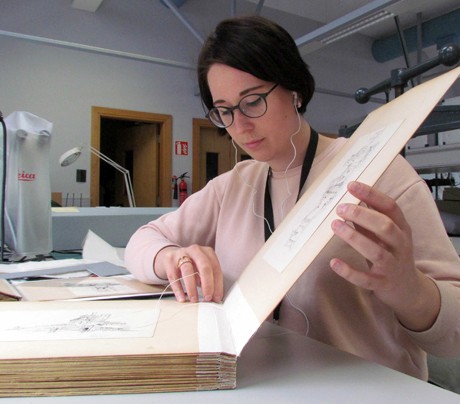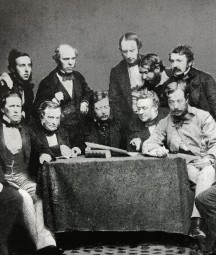Post by Claire Dantin, Conservation intern 2016-17
(NLI’s conservation internship programme is jointly run with the Heritage Council)
For a conservator, understanding the original materials of an item before any conservation treatment is essential. I recently conserved 4 albums containing beautiful prints and drawings of Irish castles by James Stark Fleming (1834-1922), a Scottish watercolour artists and architectural historian. Some of the earliest depictions of Ireland’s built heritage and landscape are found in these albums in the Library’s Prints and Drawings collection.
At some point, Fleming’s drawings were assembled into these albums, possibly by the artist himself. However poor materials and an unusual book structure meant the albums were very fragile and degraded. It was therefore important to conserve the album and not just the drawings within.
ALBUM STRUCTURE
A traditional binding is based on several sections of folded paper sewn together with thread. These 4 albums have a very different binding structure; instead of folded papers sections, there are guards hinged to pages with textile. The guards and the pages are made of very thick stiff card.

Unusual binding structure of the albums, before conservation treatment
There is no sewing; layers of thin textile and paper were then applied with animal glue to edges of the guards to form a spine. The front and back boards are attached to the spine by the lining. This structure is in fact more similar to photograph albums which were commercially available from the 1850s.

Diagrams showing the structure of one album ‘section’ (left) and these sections assembled with a spine lining (right).
CONDITION

During conservation; securing the album structure with pamphlet style stitching
The albums were in very poor condition. The binding structure was made from poor quality materials. These were now acidic and brittle - a common issue for 19th century items. Handling the album pages further damaged them. The drawings within were discoloured due to contact with acidic pages of the albums.
Following documentation, the challenge began to preserve the working parts of each album, while intervening in the most appropriate way. My conservation treatments aimed to enable safe handling of the items during the digitisation process and for future consultation or exhibition.
CONSERVATION
Adapting the binding structure
The structure of the album was the main reason for its decay. One album (TX2) required an interventive treatment approach. Its spine was completely detached, the textile hinges were torn and brittle and many pages were loose or detached.
I applied a treatment solution that respected the original structure and materials of the album. The textile hinges were delicately removed with a scalpel and replaced with a 100% unbleached cotton textile, its strength and thickness matching the original textile. The acidic spine lining was removed and replaced with flexible Kozo paper linings. The heavy boards were attached with a strong yet thin textile. The text block was then secured with a pamphlet style stitch, sewn through every two sections of the replaced textile hinges.
Flattening distorted pages

Distorted album pages and a diagram of the humidification ‘sandwich’ created to flatten them
The condition of another album (TX1) was rather unusual as it had distorted pages. The adhesive used to apply the drawings had caused the album’s pages to distort.
As a treatment solution I introduced enough moisture vapour to the album's pages to relax the papers fibres and adhesive layers. As the binding was intact, this meant I needed to create humidification ‘sandwich sleeves’ to slip over the albums pages. The pages were then gently dried under pressure to flatten the album pages. I gradually worked through the volume, by systematically humidifying and pressing each page until it was all flat.
Brittle papers
The album's pages, made from wood pulp paper, were so brittle the edges had snapped. To make the pages strong enough to be turned, I infilled the losses with several layers of Japanese papers orientated in different fibre directions. I then gently rounded the edges of the repairs to match the original pages.
The conserved albums are now stored in a bespoke archival box and digital images are on the Library’s online catalogue. With the stabilisation of the binding structure, the book can be handled and opened easily without further damage.

Brittle albums pages before and after conservation treatment

